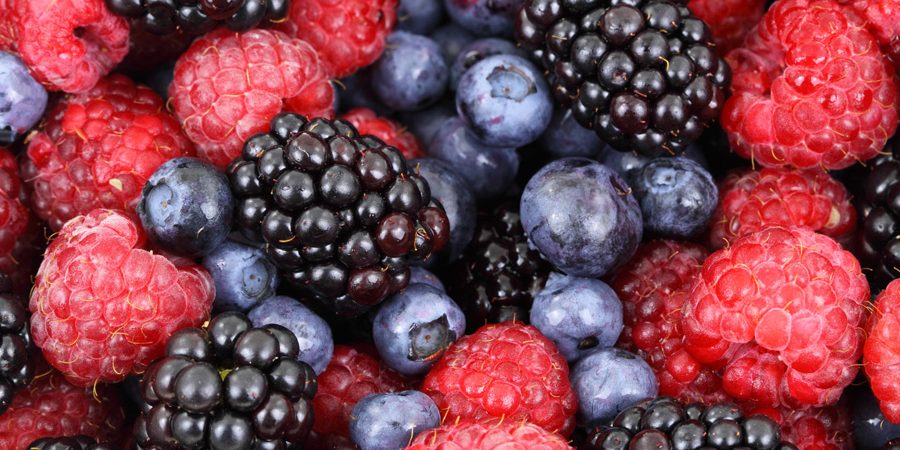Late summer and early autumn is the berry high season in Carpathian mountains. Many wild berry species are highly nutritious containing not only energy but also many vitamins, minerals and other micronutrients that are hard to find so easily, or in such concentrations, elsewhere.
Several of the berries here such as bilberry and cowberry represent very important seasonal food sources. From a bushcraft and survival perspective, all of these berries could augment your diet while out and about. Some also represent important survival foods, particularly those persisting right into the winter months.
Blackberries
Blackberries, the fruit of brambles, Rubus fruticosus agg, are ubiquitous but shouldn’t be dismissed out of familiarity. Yes, they are widespread and common but they are also sweet and flavoursome. Besides, they are a great introduction to foraging, both for kids as well as inexperienced adults wishing to learn about wild foods. Blackberries are a safe starting point for would-be foragers young and old. It’s extremely difficult to confuse these globular compound fruits with anything less benign.
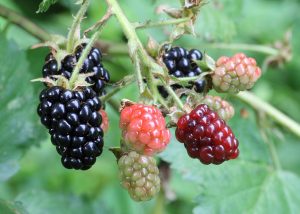
Ripe blackberry fruits are sweet and pleasing to our modern palate. This being said, there is plenty of archaeological evidence that our stone age ancestors also enjoyed these berries in abundance. The season for blackberries is pretty wide, with fruits on the same bush ripening over a period of time. The earliest ripening and often the sweetest and biggest berries are found at the ends of shoots. These should always be picked and enjoyed raw.
Later ripening blackberries are not always so flavoursome but can be added to fruit pies or made into jams for enjoyment through the winter. Blackberries are one of our best and most easily accessible wild fruits.
Raspberries
Ripe raspberries are a foragers delight. The raspberry, Rubus idaeus, like its cousin the blackberry, is an easily-identified composite fruit. Raspberry plants are more upright than brambles, with woody stems but still with prickles, particularly on the greener parts.
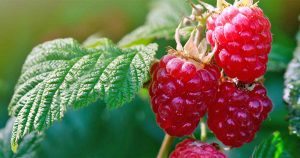
These plants tend to form a stand of multiple plants in one area. The undersides of the leaves are a silvery green. Flowers form in drooping clusers towards the ends of the stems and this is, of course, where the fruits later form. The fruits are easily picked from the plant, separating from the plug by which the berry is attached. The berries can be eaten raw or made into jams, added to desserts and puddings or even made into wine.
Red Currants
If you associate berries with autumn, then it’s easy to miss the red currant, Ribes rubrum. These fruits are typically ripe before the end of July, particularly further south. Their season does cross over with raspberries, though, and the combination of these fresh wild fruits is a very good one. The sweetness of the raspberries offsets the acidity of the red currants. Personally I like red currants on their own too but some people find them a little tart to consume in any quantity.
The tartness of red currantes comes from the acidity of the fruit, which contain, amongst other acids, a significant amount of ascorbic acid (vitamin C), with a concentration of about 40mg/100g fruit. Another reason red currants are easily missed is that they tend to be hidden in the darker, damper parts of the woods, often found in association with alder, Alnus glutinosa. The red currant plant is a deciduous shrub, with the woody cane-like stems remaining dormant over the winter.
The leaf, when it appears in spring, resembles that of a maple, with three or five lobes. The fruits are small, about the size of garden peas. If you look closely at these little red jewels, you will notice that the skins are somewhat translucent and in bright sunshine you can see seeds within. You’ll also notice there are lines from stem to base like lines of longitude on a globe. These are features it shares with gooseberries, the family of which currants share.
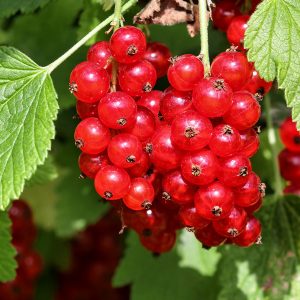
As well as eating these berries raw, you can make a fine jelly from them, if you can find enough that is. Birds and mice love these berries more than we do. If you have missed them already this year, then make sure they are definitely first on your list to look out for next year.
Bilberries
Bilberries, Vaccinium myrtillus, also known as blaeberries or whortleberries are in the same family as blueberries, which they closely resemble. When ripe they are a dark bluish-black colour with a grey bloom on them, similar to that of some grapes. Bilberry juice stains (for example your fingers or your tongue) a deep bluish-purple colour. The plant is a low-growing shrub with green oval leaves.
It is found covering significant areas on heaths and moors as well as in the woods under pine or oak, particularly in acid soil. The berry is more compact and flavourful than its North American cousins, ripening from July through September. It’s relatively easy to pick a good amount in areas where it is abundant, although some people use specialised berry-catchers to collect the fruits more rapidly.
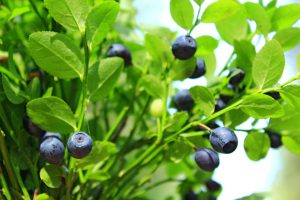
Despite its excellent taste and historical importance as a food source, the bilberry is largely overlooked these days. This is shame as in addition to being delicious, it contains vitamin C, provitamin A and antioxidants. Bilberry fruits have been shown to have hypoglycaemic and antidiabetic effects ). The fruits can be eaten raw but also added to bannocks, muffins, pies, jams and jellies.
Cowberries
Cowberry, Vaccinium vitis-idaea, is closely related to bilberry but in a number of respects is quite different. The plant is a low-growing, spreading small evergreen shrub. It has glossy oval leaves, turned down around the edges with a lighter underside and visible glands underneath. It’s widespread on moorlands and heaths, often alongside bilberry. The fruits are red and are edible but really quite unpalatable, being very sharp and acidic. The unpleasant taste of the raw berries comes from the presence of both benzoic acid and oxalic acid.
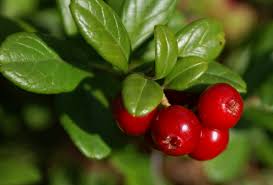
You can make a decent fruit leather from the fruits and with the addition of some pectin from, say, apples a good jelly can be made. Interesting is the fact that the constituent benzoic acid is a natural preservative of the berries, which means, unlike its cousin the bilberry, which is prone to fermentation if stored, cowberries can be easily preserved, even just stored in water.
Elderberries
This species is a very common large bush or small tree of woodlands, hedges and scrub. Taking the place of the lacy florets of flowers, the small berries start green then ripen to a dark purple, almost black, hanging down in dense clusters. It has been used for a range of cordials, sauces, jellies and puddings.
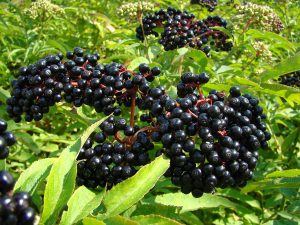
It’s generally recommended the berries shouldn’t be consumed raw, though, certainly not in any great quantity. All green parts of the plant, including the berries, are mildly irritant as well as containing cyanogenic glycosides. There is also a distinctive and somewhat unpleasant sharp smell to the crushed leaves or shoots. Eating quantities of raw berries, particularly if a little unripe, can cause stomach upsets, including nausea and vomiting. The problematic compounds are nullified by heat, so cooking the fruit is always recommended. Strip the berries off the stalks (a fork is handy for this job), discarding the latter. Jams made from mixing the fruit with gooseberries are particularly good.
Rowan
The rowan, or mountain ash, Sorbus aucuparia, is a small- to medium-sized tree native to Carpathians. It has silvery bark and pinnate, compound leaves, somewhat resembling feathers. Rowan is in the rose family and the fruits bear some resemblance to those of other members of the rose family. Most obvious is that the red fruits look like miniature apples, clustered together in hanging bunches.
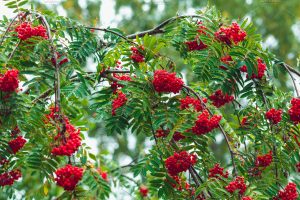
Even though they smell quite pleasant when crushed, the taste taste of raw rowan berries is really quite nasty. The berries start to ripen in August to late September. If you try one or two, you’ll find they are bitter and astringent. They do contain a reasonable amount of ascorbic acid, vitamin C, but also other compounds including malic acid, which makes the berries sour, and parasorbic acid, which causes indigestion and nausea. Heating the berries converts the parasorbic acid to the benign sorbic acid and generally improves the flavour.
Hawthorn
Also in the rose family, hawthorn species all have edible fruits. The most common hawthorn species in the Carpathian mountains is Crataegus monogyna, what most people call just “hawthorn”. It’s a common, widespread and familiar large bush or small tree of woodland understorey, scrub and hedgerows, obvious in the spring due to its abundance of white flowers, often referred to as “May”.
The berries – called haws – ripen around August to a shiny scarlet red. They contain a single stone, which is quite large, so teeth beware. The best way I have found of eating them raw is to place the small fruit in your mouth and nibble away the flesh using your front teeth, before spitting out the pip. The flesh is not particularly sweet, though, tasting quite like the leaves do in the spring.
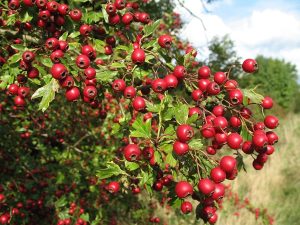
The berries will stay on the branches for many months, often right into the depths of winter. They turn a less vibrant shade of red over this time and do dry out somewhat as they do so. Hawthorn has long been held by herbalists as a cardiac tonic. More recent scientific research has show there is significant potential for hawthorn preparations in the treatment of cardiovvascular disease.
Rosehips
A set of species very obviously part of the rose family are the wild roses in the genus Rosa. All species produce rose-hips, which are the fruits. Rosehips contain hairy seeds in the centre, surrounded by (normally red) flesh that is quite acid to the taste. Rosehips can be consumed raw. Simply remove the hairy seeds, which can be an irritant to the throat, from the centre of each hip, maybe rinsing them a little afterwards. The pulpy flesh is then ready to consume.
Rosehips have long been used in herbal medicine, considered good for coughs and sore throats amongst other things. The hips contain a good amount of ascorbic acid, vitamin C. Fresh hips contain 0.1-1.0% ascorbic acid – around ten times the concentration found in orange juice.
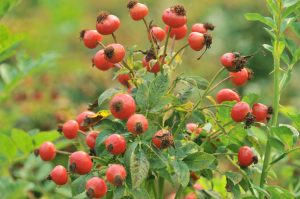
There are many other nutrients in rosehips too. In addition to the vitamin C, rosehips contain an impressive array of other nutrients, particularly pro-vitamin A, vitamins of the B group, vitamins P, K and E.

